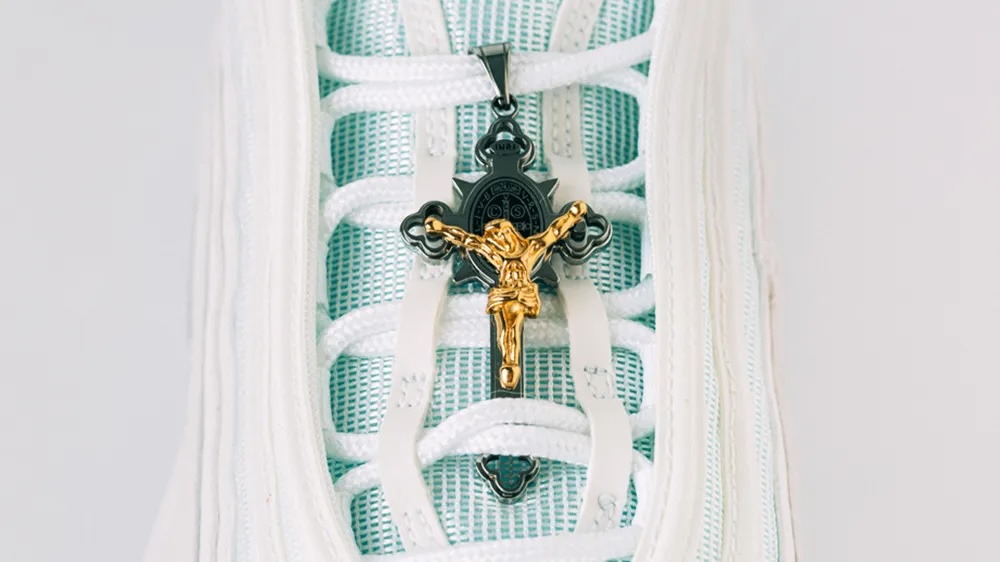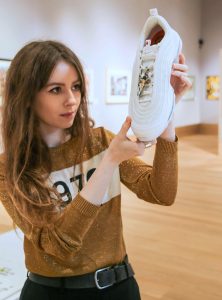2019 MSCHF X INRI Jesus Shoes

Religion: Christianity
Time Period: 2010s
Type Of Garment: Shoes
Tags: Cross, Everyday, Holy Water, Parody, Sneakers, United States
The Object:
Using the body of a Nike Air Max 97, MSCHF and INRI (Iesus Nazarenus Rex Iudaeorum) created the “Jesus Shoe.” Iesus Nazarenus Rex Iudaeorum, meaning Jesus the Nazarene, King of the Jews, was a fake brand invented by MSCHF to imply a religious collaboration between the two and infuse a sense of authenticity in their design. The shoe may appear to be a simple blue and white mesh build, but it features “60cc of holy water injected into the Max Air unit, the pair allows you to walk on water” (Sotheby’s). The shoe also features a gold and steel crucifix embedded within the white laces of the sneaker. Branding from the parent company, MSCHF, is visible on the left heel tab, while INRI appears on the right heel tab reinforcing the collaborative sensibility. A black stamp that reads “MT 14:25” is on the side of the shoe, a reference to Matthew 14:25. This verse reads: “And in the fourth watch of the night Jesus went unto them, walking on the sea,” emphasizing the intended wearer’s ability to walk on water like Jesus (MSCHF).
At their initial release date, these shoes were listed for $1,425, a reference to the verses imprinted on them; however, due to their rarity and demand, resellers like Sotheby’s have offered the shoes for prices upwards of $2,500.

The Creator:
MSCHF is a collective of ten people based out of New York, New York. Their group is composed of nine men and one woman who have made it their goal to produce odd items, often out of parody, to create a sense of exclusivity and creativity. Characterized as the “Banksy for the Internet” by the New York Times, MSCHF releases limited biweekly drops available through their brand website and word of mouth, and potential buyers are offered no preview of the items before their release (Meyer).
This sense of whimsy and boundary-pushing makes the brand desirable, as people want to have one of their creations, no matter how useless or controversial. The brand rarely works with other brands, and when they do, it is often a one-sided exchange, where MSCHF takes items from known brands and then adds their twist. Because of this, MSCHF has had many legal run-ins with brands, like Nike, for their unapproved use and marketing of these products. The MSCHF collective promotes itself as an avant-garde movement within the art world. And the public demand for MSCHF items, especially the Jesus Shoes, has quickly become a social phenomenon, and the demand for more religiously-coded items from similar brands has grown.

With no social media presence except for its website, MSCHF relies heavily on promoting its products through celebrities, and the controversy that results from its product drops. Their X, formerly Twitter, and Instagram accounts, are currently private, and the brand does not use public advertisement before their releases. MSCHF understood the potential social recognition that the Jesus Shoes would garner from their release, and they were right as they became the “most Googled shoes of 2019” (Meyer). Catering to sneaker collectors, also known as sneakerheads, as well as curious MSCHF supporters, the company knew that there was a demand for their controversial sneaker. By pushing the boundaries on brand partnerships, as well as the confines of appropriate religious expression, MSCHF enhanced their risk-taking artistic reputation.
Along with the Jesus Shoes, MSCHF also produced the Satan Shoe, a notable contrast to its counterpart. This shoe garnered a similar adverse and curious reaction from the public and was created in partnership with Lil Naz X, a singer who upholds the same unorthodox ideals of MSCHF. Also designed with the Nike Air Max 97 shoe, it featured an upside down cross, a bronze pentagram, and a drop of human blood. In response, Nike sued MSCHF and distanced itself from MSCHF’s art and the shoe’s messaging. (Business Mirror). Nevertheless, MSCHF remains undaunted and continues to produce provocative products and “collaborations.”
Overall, MSCHF’s shocking social commentary remains constant throughout its product releases, and it offers wealthy buyers the opportunity to cash in on its collection of unconventional art. There is beauty in the brand’s controversial nature and the social backlash and wonder it produces.
The Wearers:

The wearers are collectors and MSCHF enthusiasts who aim to push the boundaries of art and fashion. Most buyers of the shoe do not wear it, but instead prop up the shoes in a protective case in their home to keep their value. While this may seem counterintuitive, only 24 of the shoes were produced, making them a rare commodity that buyers treasure for their historical value as an art piece that garnered controversy between the church, Nike, and MSCHF.
Rappers like Drake have been seen wearing the Jesus Shoe, which suggests a modern acceptance of clothing featuring religious symbols in everyday wear. Wearers are often also seen wearing religious-coded clothing from brands such as Fear of God and Noah and less religiously related popular clothing brands like Supreme and Off-White. The intersection between religion and streetwear has quickly become one of the most prominent fashion trends within the last ten years; therefore, the release of the Jesus Shoe aligns with current fashion trends as well as catering to wealthy supporters of the arts who want to display or critique religious beliefs.
The Context:
Religious parody has always been greeted with mixed reactions. Some are in favor of criticizing the systems we have adopted and followed for centuries, while others perceive parody as a direct challenge to their identity. MSCHF has made it their goal to push the status quo around what is acceptable, and the Jesus Shoes fall directly in line with this mission, raising questions around the integral role religion has in fashion and perhaps overly literal interpretations of the Bible.
The Jesus shoes directly invoke associations with religion by including the verse from Matthew 14:25, which alludes to Jesus walking on water, and the gold crucifix affixed to the shoelaces. MSCHF’s website highlights the biblical verse, “And in the fourth watch of the night he came to them, walking on the sea,” under the listing of the sneakers, directly tying the shoes to a concrete passage and Jesus (MSCHF).
While their inclusion of the verses does not inherently act as a parody of religion, understanding the company’s motivations behind the creation of the project guides the reader to understand them as parodies. The MSCHF brand commented in an interview:
“We set out to take that to the next level…what would a shoe collab with Jesus look like? Obviously, it should let you walk on water. Well, how can we do that? You pump holy water into the pocket of a pair of Air Max 97’s… the holiest collab ever”
Baker
The brand makes it clear the sneakers were not created out of religious reverence, but rather out of social (and humorous) commentary. MSCHF’s Jesus shoe not only highlights the absurdity of overly literal biblical interpretation, but also the religiosity of the casual, which dominates popular culture and has influenced recent fashion trends that promote casual flexes of money in everyday wear.
Overall, the intersection between religion and everyday wear, as seen in the Jesus Shoes, holds power even today, five years after its release. While MSCHF has produced many other items that carry arguably the same weight, the Jesus Shoe stands as one of the most influential garments that raises questions about popular culture’s intersection with religion, which is why it should be observed as a piece of wearable art, as well as a historical product of innovation, and a key player in the legacy of religion infused apparel.
Heidi Vander Schaaff, Spanish and Religious Studies Double Major (WFU ‘27).
3 October 2024
Tags: Cross, Everyday, Holy Water, Parody, Sneakers, United States
References:
Baker, Chris. “Nike Air Max 97 ‘Jesus Shoes’ Filled with Holy Water Selling for $4,000.” CBS News, October 11, 2019. Accessed September 15, 2024. https://www.cbsnews.com/news/nike-air-max-97-jesus-shoes-filled-with-holy-water-selling-for-4000-2019-10-11/.
Meyer, Robinson. “The Sneaker That Has Holy Water in the Sole.” The New York Times, January 30, 2020. Accessed September 15, 2024. https://www.nytimes.com/2020/01/30/style/MSCHF-sneakers-culture.html.
MSCHF. “Jesus Shoes.” Accessed October 2, 2024. https://jesus.shoes/.
“‘Satan Shoes’ Recalled as Nike, MSCHF Settle Suit.” Business Mirror (Makati City, Philippines), April 9, 2021. Gale General OneFile. Accessed September 15, 2024. https://go.gale.com/ps/i.do?p=ITOF&u=nclivewfuy&id=GALE%7CA660095813&v=2.1&it=r&sid=bookmark-ITOF&asid=197e83d4
Sotheby’s. “MSCHF x INRI Nike Air Max 97 ‘Jesus Shoes’.” Sotheby’s.com. Accessed September 18, 2024. https://www.sothebys.com/en/buy/_MSCHF-x-INRI-Nike-Air-Max-97-Jesus-Shoes-or-Size-12.
